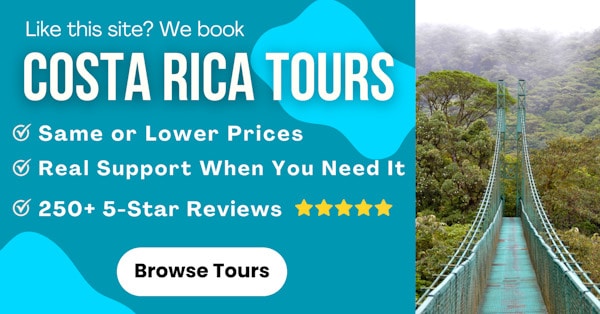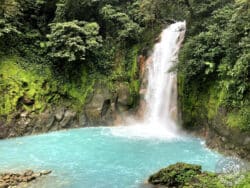Last Updated: July 8, 2025
Set in the highlands in rural northwestern Costa Rica, the Rio Celeste Waterfall is a breathtaking natural wonder one has to see to believe. The brilliant blue water gets its show-stopping hue from a chemical reaction between volcanic minerals, making it stand out among Costa Rica’s many waterfalls. A walk through Tenorio Volcano National Park will let you see (and smell) the Rio Celeste turn from clear to vivid turquoise. You also will get a close up of the waterfall, which has become one of the country’s most popular attractions.
We have been to the Rio Celeste Waterfall several times now. Below we share the essentials for planning your visit.
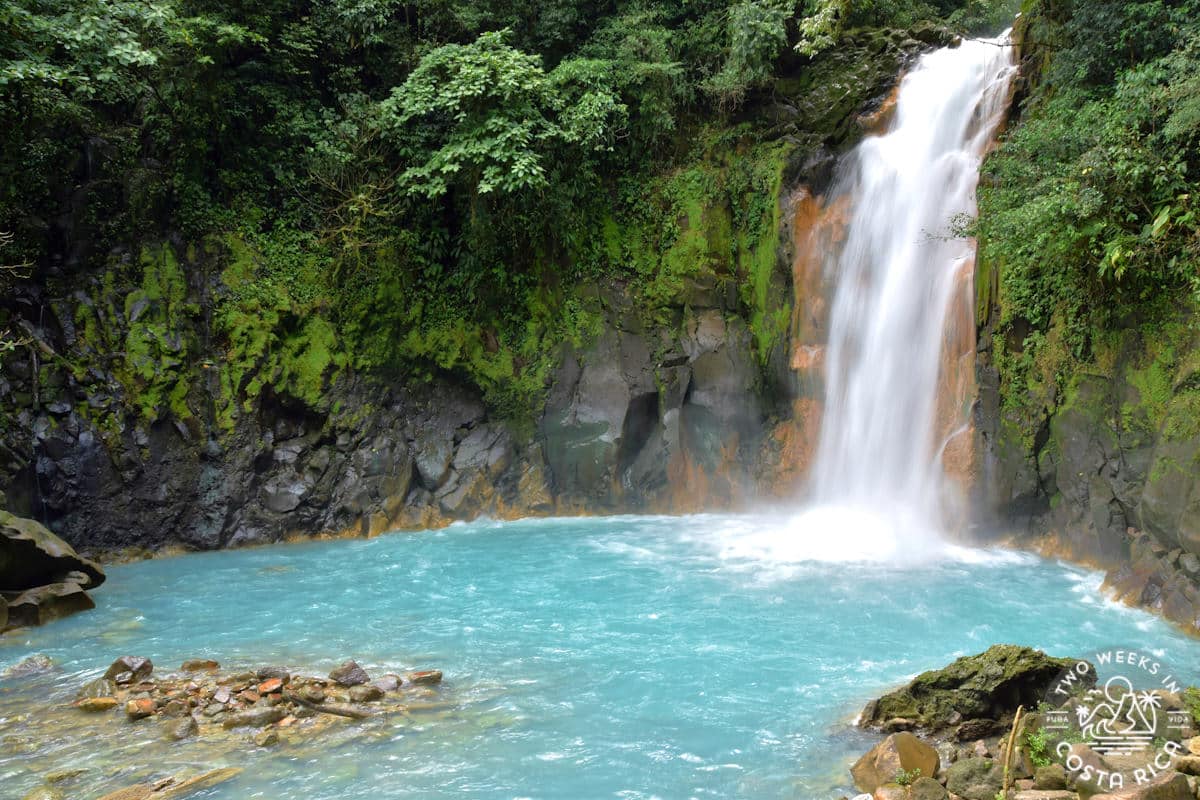
Orientation
Tenorio Volcano National Park, where the Rio Celeste is located, is a lofty 31,794 acre (12,867 hectare) swath of lush jungle.
The towns closest to the park are the small towns of Bijagua to the west and Katira to the east.
This area of Costa Rica is very rural and quiet. The landscape consists of verdant rolling hills, farmland, and pasture, complete with plenty of grazing cattle.
If you’re looking for an authentic travel experience, be sure to spend at least a couple of nights in this region. Because it’s more remote and has fewer amenities, it sees far fewer tourists than other parts of the country.
Read our complete post Bijagua: A Gateway to the Rio Celeste Waterfall to plan your visit.
Park Entrance
Tenorio Volcano National Park has one entrance. It’s about 20 minutes from the town of Bijagua along a paved road. If you’re planning to visit on a day trip from La Fortuna/Arenal, the drive will be about 1.5 hours.
See below for directions. We will cover the best way from La Fortuna/Arenal as well as from Bijagua and Guanacaste Province.
Trail
The hike to the Rio Celeste Waterfall is moderately difficult if you do the entire trail.
The first section leading to the waterfall, however, is a lot easier. This is a nice option for those not interested in a strenuous hike. Below, we will describe both portions of the trail.
You can visit the park in an hour or two if you only want to see the waterfall. But if you want to see everything, allow 3-4 hours.
Here’s a link to the trail map to help you get your bearings.
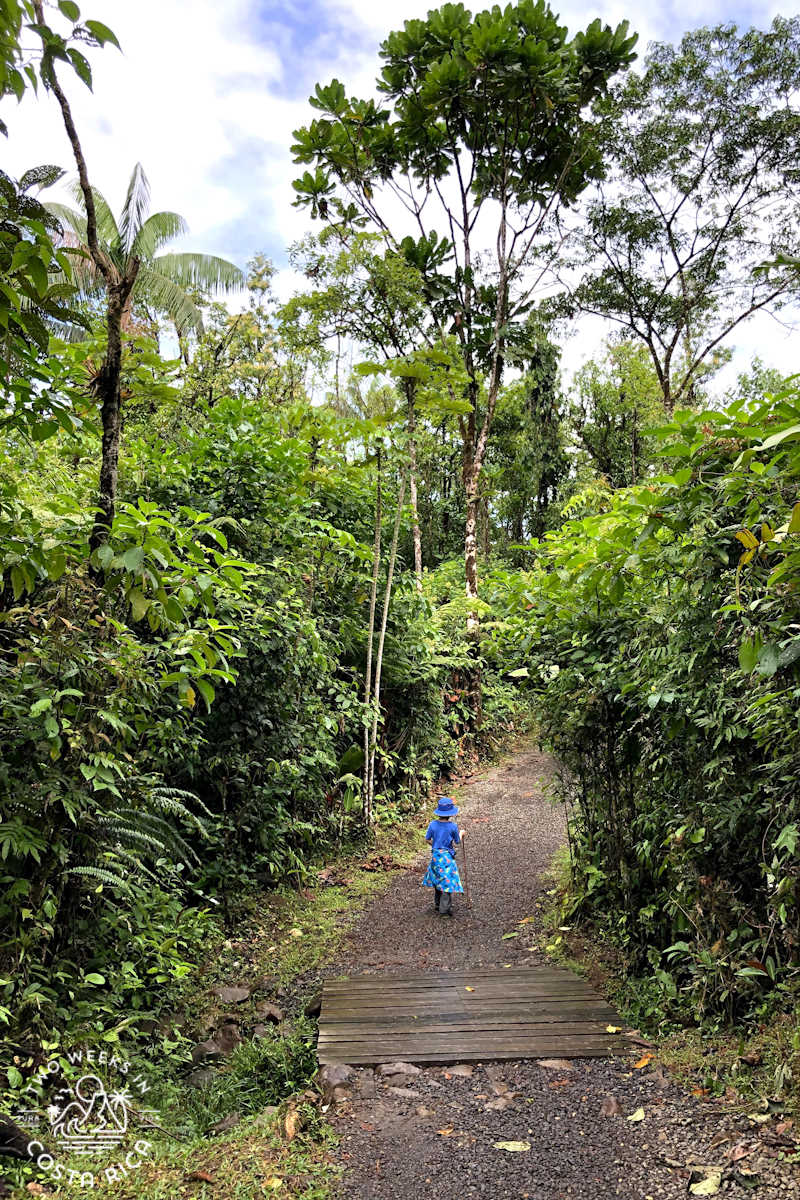
Trail to Rio Celeste Waterfall
From the ranger station, the trail leading to the waterfall goes through lush forest along a nicely paved, flat path.
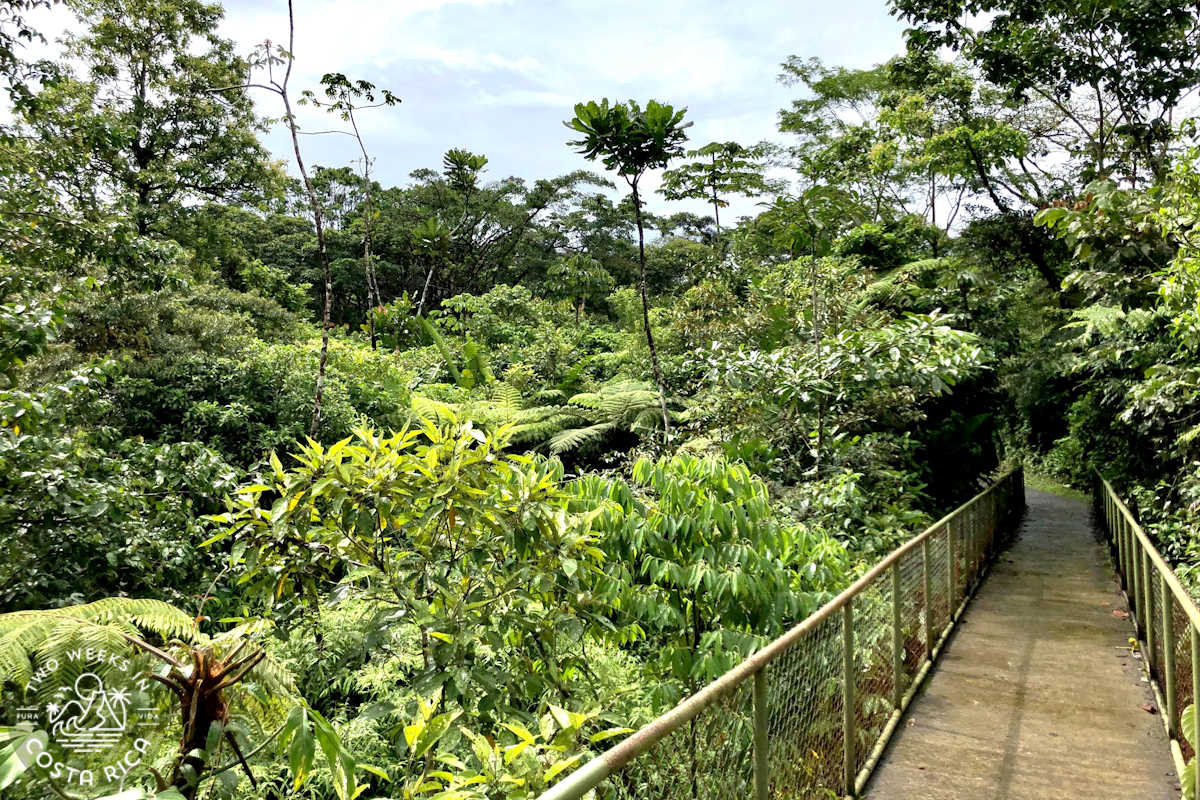
After about 15 minutes, the pavement ends and turns to gravel, then a regular dirt trail. The hike to the waterfall is about 30 minutes in total.
Along the dirt portion, you will encounter some short steep areas, a small stream crossing, and rocks to navigate around. This portion of the hike is fairly easy. Our kids have walked it themselves at five years old and we have carried them in baby carriers as well.
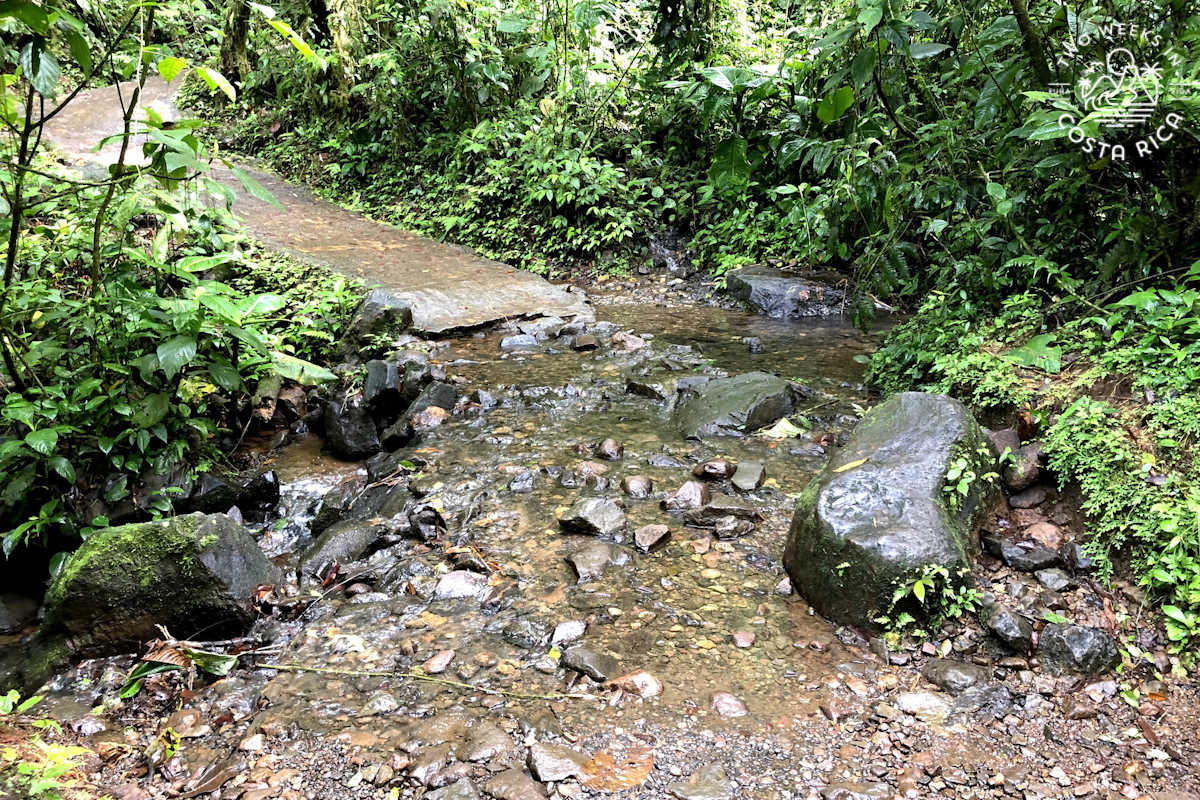
Once you reach the waterfall, it is a long 250 steps down a nice staircase to get to the viewing platform.
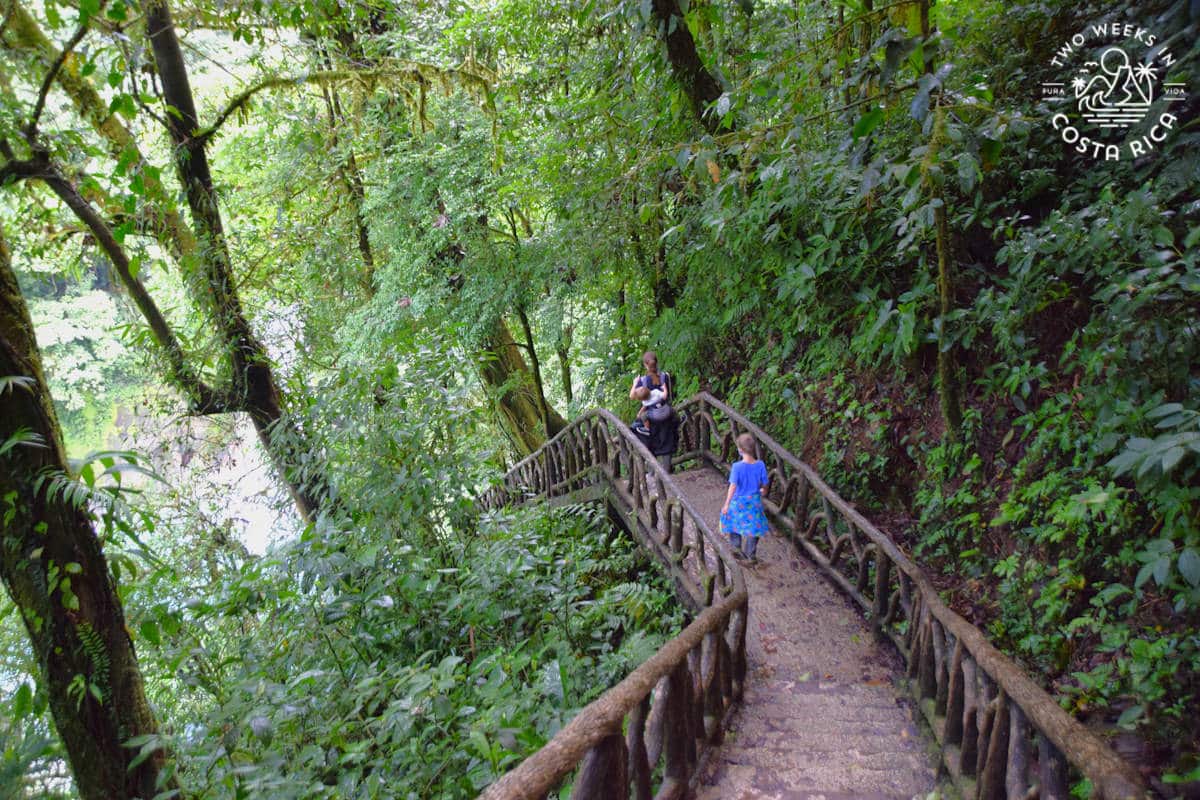
Viewing Platform
The area around the falls is closed off and no swimming is allowed, but you will be close enough to get some amazing pictures.
The Rio Celeste Waterfall is 90 meters (295 ft) tall and cascades into a deep blue pool surrounded by thick green vegetation.
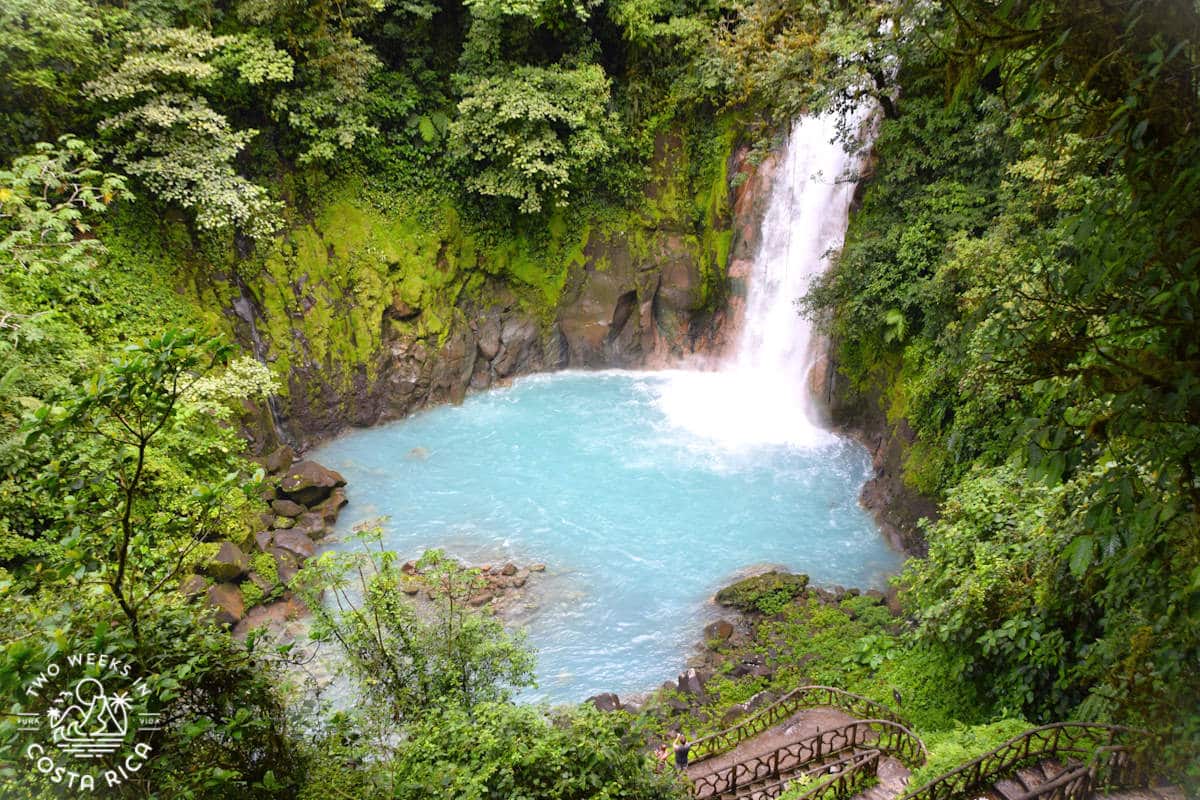
Tip: A great way to swim in the blue river is to do a tubing tour. These are outside the park limits and are super fun! We loved the beautiful scenery and gentle rapids.
Check out our short video of Rio Celeste Waterfall
IMPORTANT: The best time to visit the Rio Celeste is during the dry season of December to April, as rain can cloud the water and dull the turquoise effect.
Trail After Waterfall
Many people turn around after they have visited the waterfall, but there are some beautiful sights if you keep going.
The second part of the hike is more difficult.
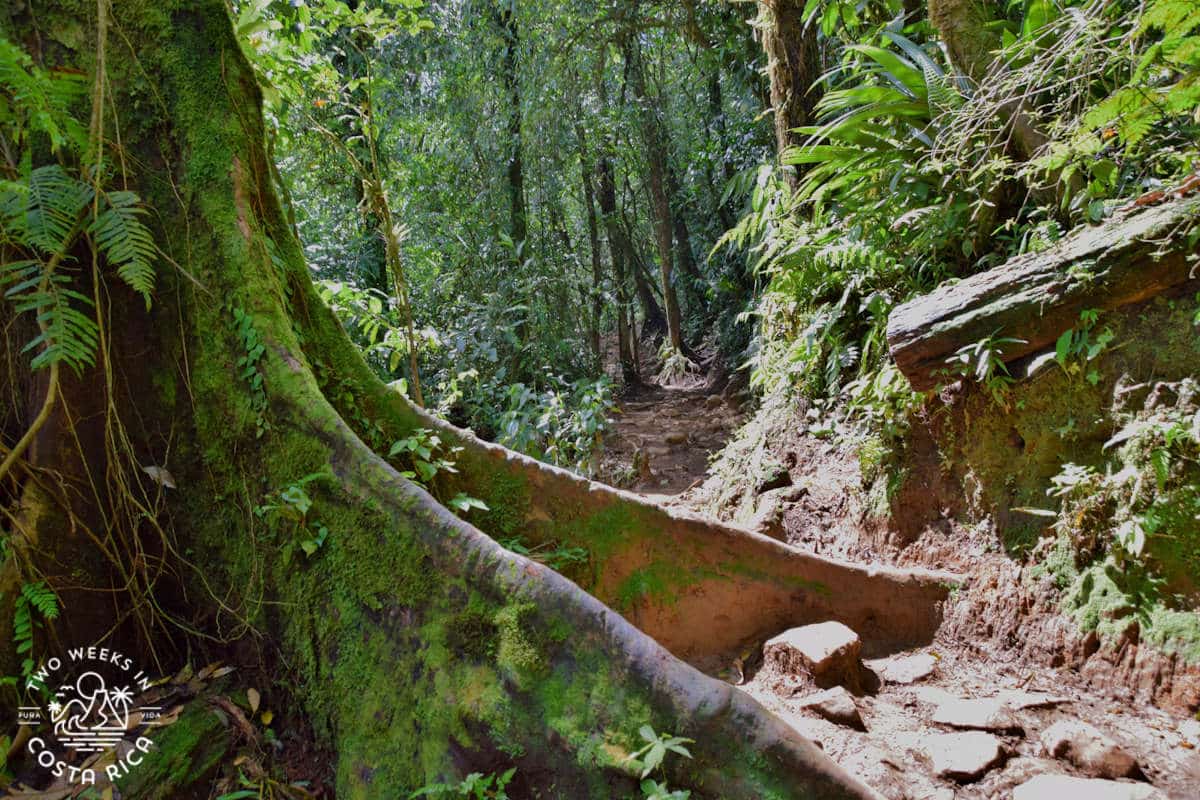
From the waterfall, the trail meanders uphill before descending to the serene river. After climbing up and then down some steep inclines, around slippery tree roots and irregular terrain, you will come to the Poza Azul.
This is a lovely blue pool where you will want to take plenty of photos. Note that despite some old maps and publications, swimming is no longer permitted anywhere in the park.
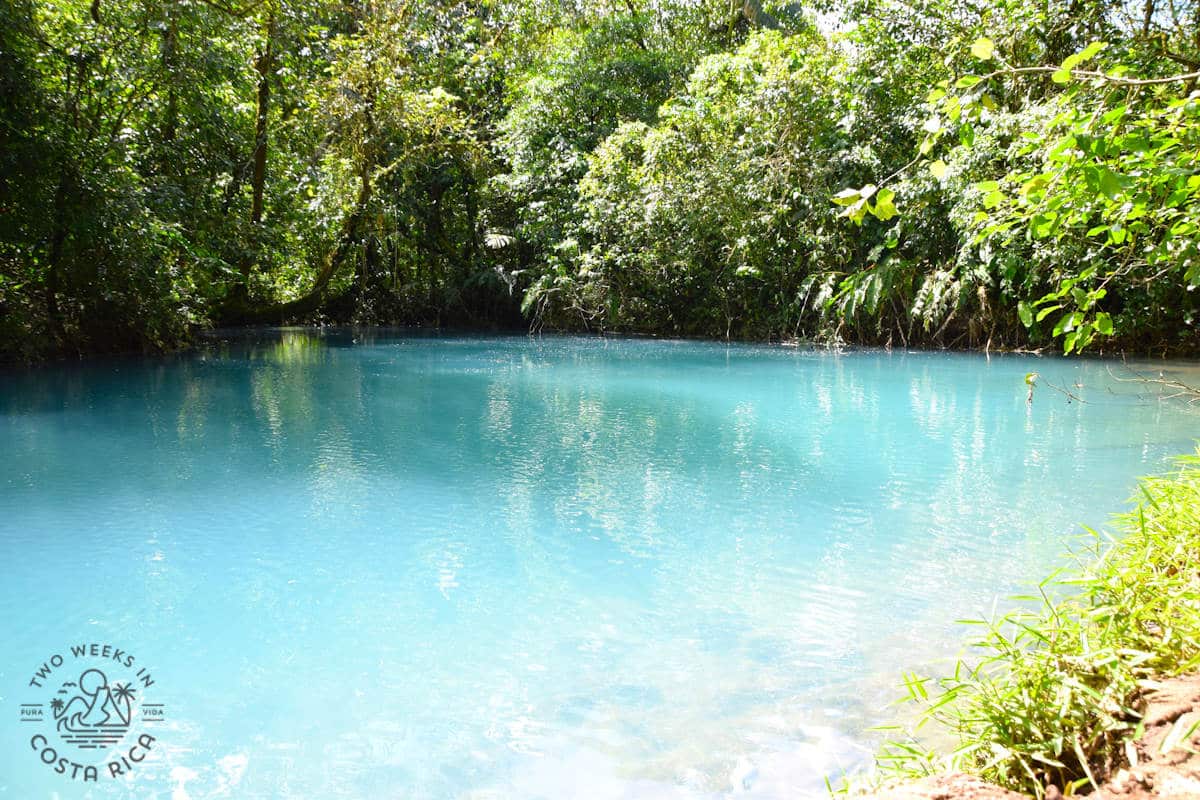
Continuing on, you’ll pass over the river using a couple of small hanging bridges.
Next you’ll reach one of the most interesting features of the park, the tenideros.
This is the point where two rivers converge and the magical chemical reaction occurs. Both rivers have water that is crystal clear, but where they meet, it suddenly turns a stunning blue.
You may also detect a strong odor here from the chemical reaction between the sulfur and calcium carbonate, which causes the color change.
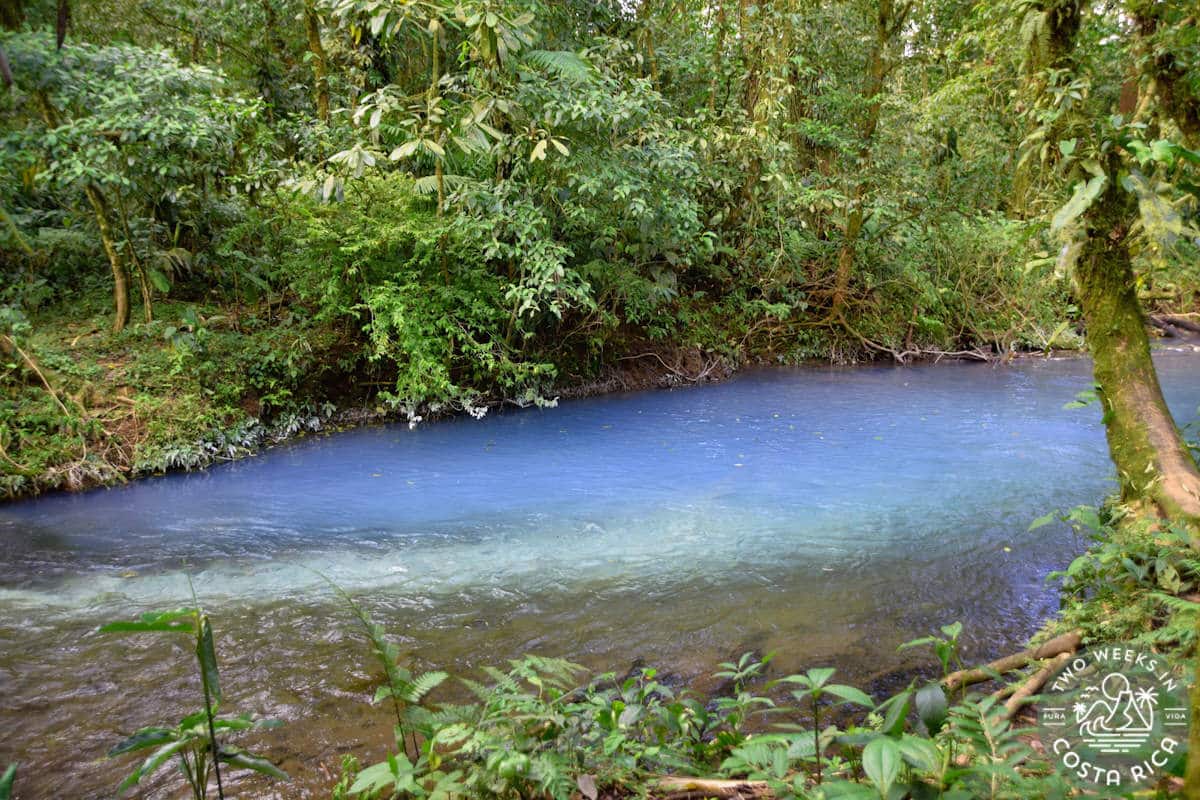
The trail dead-ends at the tenideros so you will just go back the same way you came to return to the ranger station.
Wildlife and Scenery
The stunning waterfall and river are definitely the highlight of a visit to Tenorio Volcano National Park, but there is more to enjoy as well.
The surrounding scenery is beautiful, even if you do only the short portion of the hike.
The park is at a higher elevation and hosts primary cloud forest as well as wildlife-rich rainforest.
On our visits, we have seen white-faced monkeys, white-nosed coati (a raccoon-type animal), frogs, and many birds, including some more rare species like the Black-capped Pygmy-Tyrant and Keel-billed motmot.
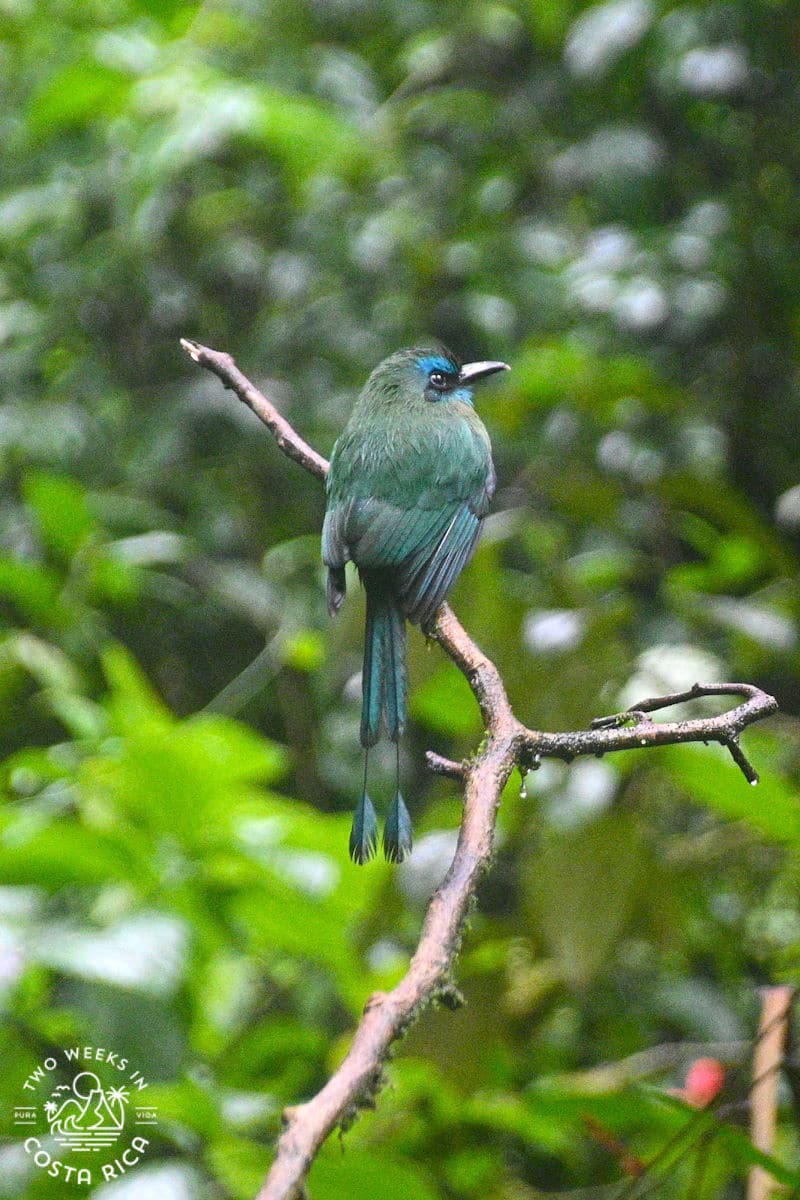
If you’re very lucky, you could even cross paths with a Baird’s tapir. The tapir is the largest land mammal in Central America. Though hard to spot, we do know people who have been lucky enough to see one right on the trail!
Planning Your Visit to Rio Celeste Waterfall
Guided vs. Unguided Tours
You definitely don’t need a guide for the Rio Celeste Waterfall hike. The trail is easy to follow and well maintained.
However, nature guides do add a lot of value and will help you see wildlife. On our last visit, our guide pointed out a really cool eyelash pitviper snake curled up on a rock beside the trail. We definitely would have missed it by ourselves.
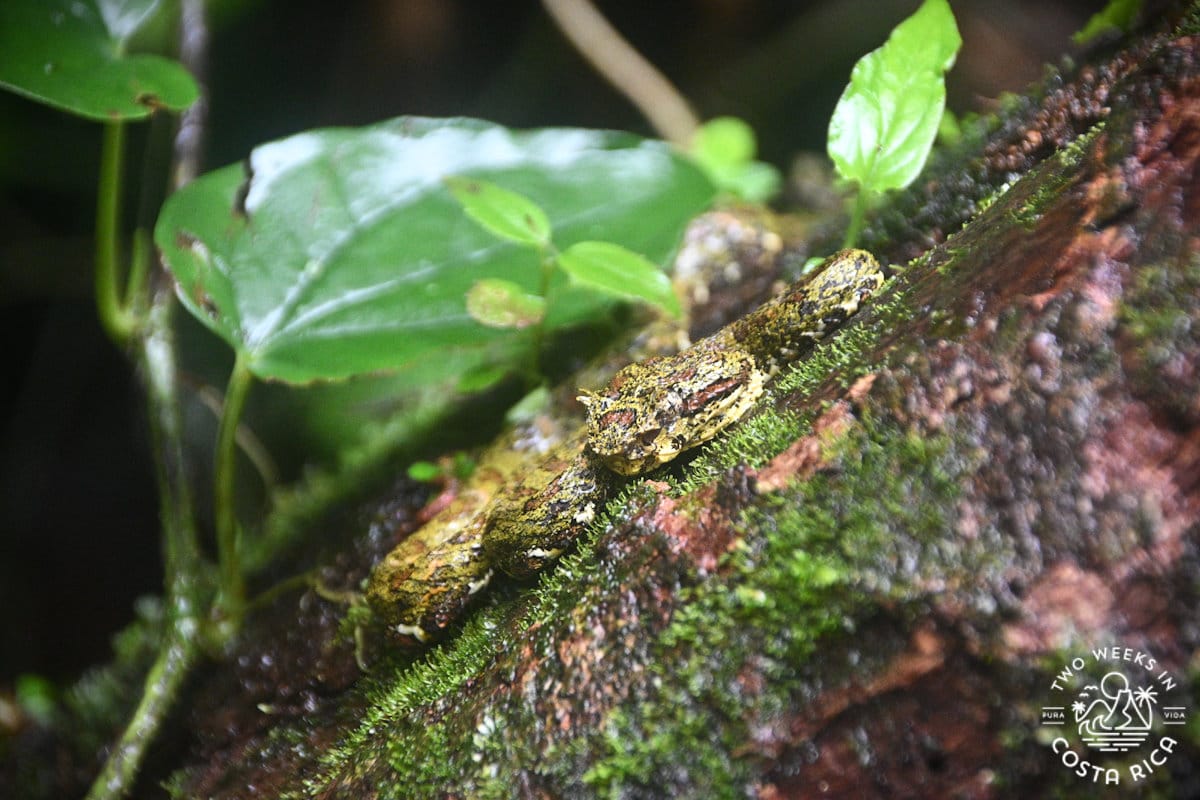
Booking a Guide
If you’d like to go with a guide, we’d be happy to connect you with the tour company we used. Booking through our local travel agency doesn’t cost you anything extra and helps support our website.
Just use the booking form below and we will contact you by email once the tour is confirmed.
Buying Tickets Online
IMPORTANT: Like many popular national parks in Costa Rica, you need to buy tickets online in advance through the park service’s website (SINAC). You will need to register for an account first. English is available.
In-person tickets are not sold and you will have to purchase them on your phone if you don’t already have them. It’s best to buy in advance as the reservations system can be clunky.
***Be sure to take a photo of your passport or have a copy handy in case the park rangers want to see it.
Cost
Visitors: $12/adult. $5/child ages 2-12
Citizens and Residents: ₡800/adult, ₡500/child ages 2-12
Hours
Tenorio Volcano National Park is open daily, 8:00 a.m. to 4:00 p.m.
Important: Even though the park is open until 4 p.m., last admission is at 2 p.m.
Best Times to Visit to Avoid the Crowds
Since the Rio Celeste Waterfall has become very popular, the trail can be crowded.
Peak visiting times are around 10:00 a.m. when tour buses from La Fortuna/Arenal and Guanacaste typically start arriving.
It’s best to start early and arrive around 8:00 or 8:30 a.m. if you can.
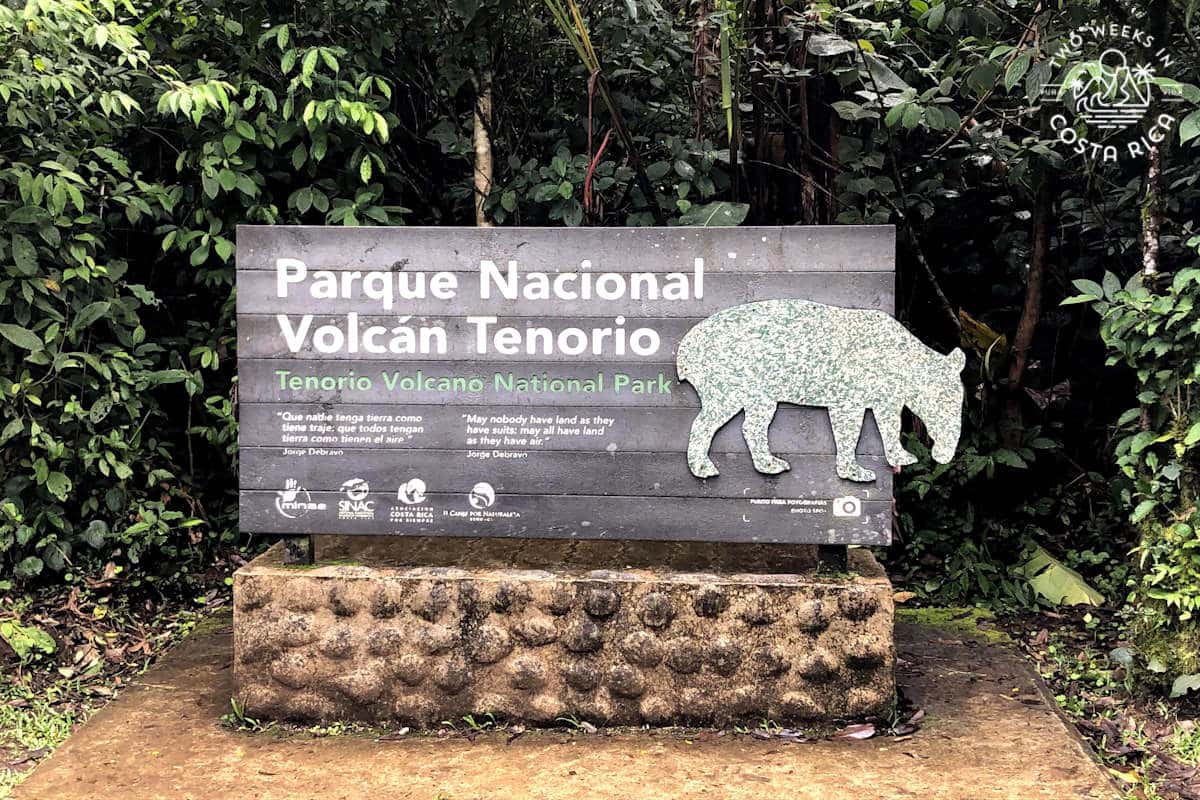
What to Bring/Wear
- Footwear: We recommend either hiking boots or sneakers that you don’t mind getting dirty. This area of the country receives a lot of rain so the trail is often muddy.
- Clothing: Mornings can be cooler here with temperatures in the lower 70s, but it does heat up quickly. If you’re getting an early start, lightweight pants and layers are best. If you’re not starting the hike until later in the morning, shorts and tee shirts are fine.
- Rain jacket – Pack a light raincoat or poncho just in case.
- For more general tips, read our post about packing your day pack for Costa Rica.
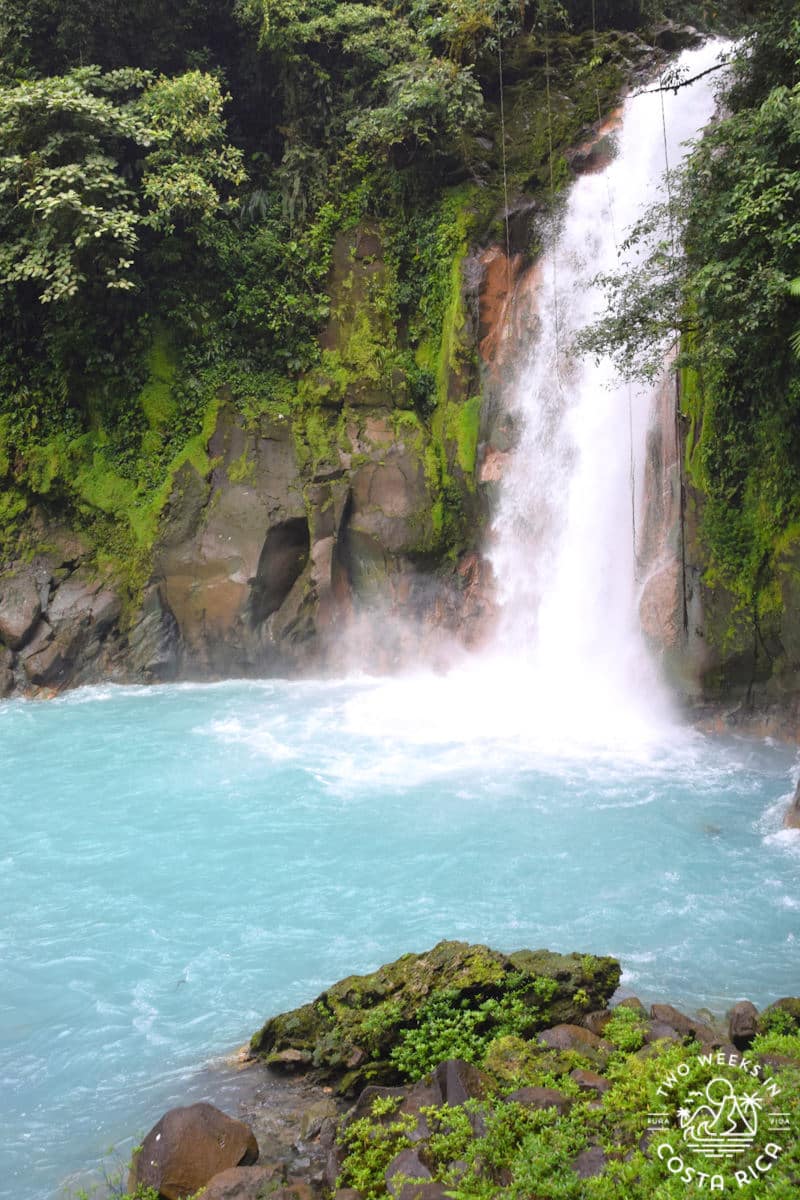
Other Important Info
Single-use plastic bottles are not allowed in the national park so be sure to bring a reusable water bottle.
No food is allowed (though the rangers will make exceptions for babies and young children).
The park rangers will check your bags upon entry and confiscate things that aren’t permitted.
If you’re hungry after the hike, there are a couple of restaurants right near the ranger station that serve traditional Costa Rican food. We have tried the one closest to the ranger station and the food was great!
Directions to Rio Celeste/Tenorio Volcano National Park
From Bijagua or Northern Guanacaste (Liberia, Tamarindo, etc.)
From Liberia, head south along the Inter-Americana Highway (Route 1). About 6 km (3.7 miles) before the town of Canas, take the off-ramp and go under the highway, connecting with Route 6 towards Upala. Follow Route 6 for about 22 km (13.6 miles) to Bijagua. Route 6 is a well paved road. Once you enter the small town of Bijagua, look for a sign for Tenorio Volcano National Park. Take a right onto the paved road at the sign.
This road is now fully paved all the way to the national park entrance. It is steep in places and can be slick if it has rained recently. There are also a couple of one-lane bridges where you may need to yield to oncoming traffic (common in Costa Rica). Check out our Driving in Costa Rica post for more tips.
4×4 is not necessary to access the park from this direction.
From La Fortuna/Arenal
From La Fortuna, connect to Route 4 using Route 142, near El Tanque. Follow Route 4 north for about 40 km (25 miles). You will continue through San Rafael de Guatuso until an area called Samen. Here, you will see a sign for Tenorio Volcano National Park. Turn left at the sign and follow this paved road for another 19 km (12 miles), following the occasional signs for the park.
You will pass through some small rural towns like Maquencal and the town of Rio Celeste itself. Tenorio Volcano National Park’s entrance will be on the left, shortly after crossing a bridge over the river (Look to see if it is blue in color when you pass over). 4×4 is not required.
*Note that some maps like Waze or Google will try to have you take a left too early off Route 4 (near San Rafael de Guatuso). That was a road used in the past but it is now better to continue to Samen, where you can connect with the paved road.
Parking
The ranger station has a large parking lot for ₡3,000 (about $6). You will pay when you arrive.
Attendants will help watch your car, but as always in Costa Rica, don’t leave anything valuable inside.
If the main lot is full, there’s another lot across the street.
Conclusion
The Rio Celeste Waterfall is definitely a must-see for those travelers looking to check another one of Costa Rica’s natural wonders off their list. For us, this unique river and waterfall only confirmed what we already knew: that Costa Rica can keep surprising you with its magical beauty time and time again.
Pin It for Later
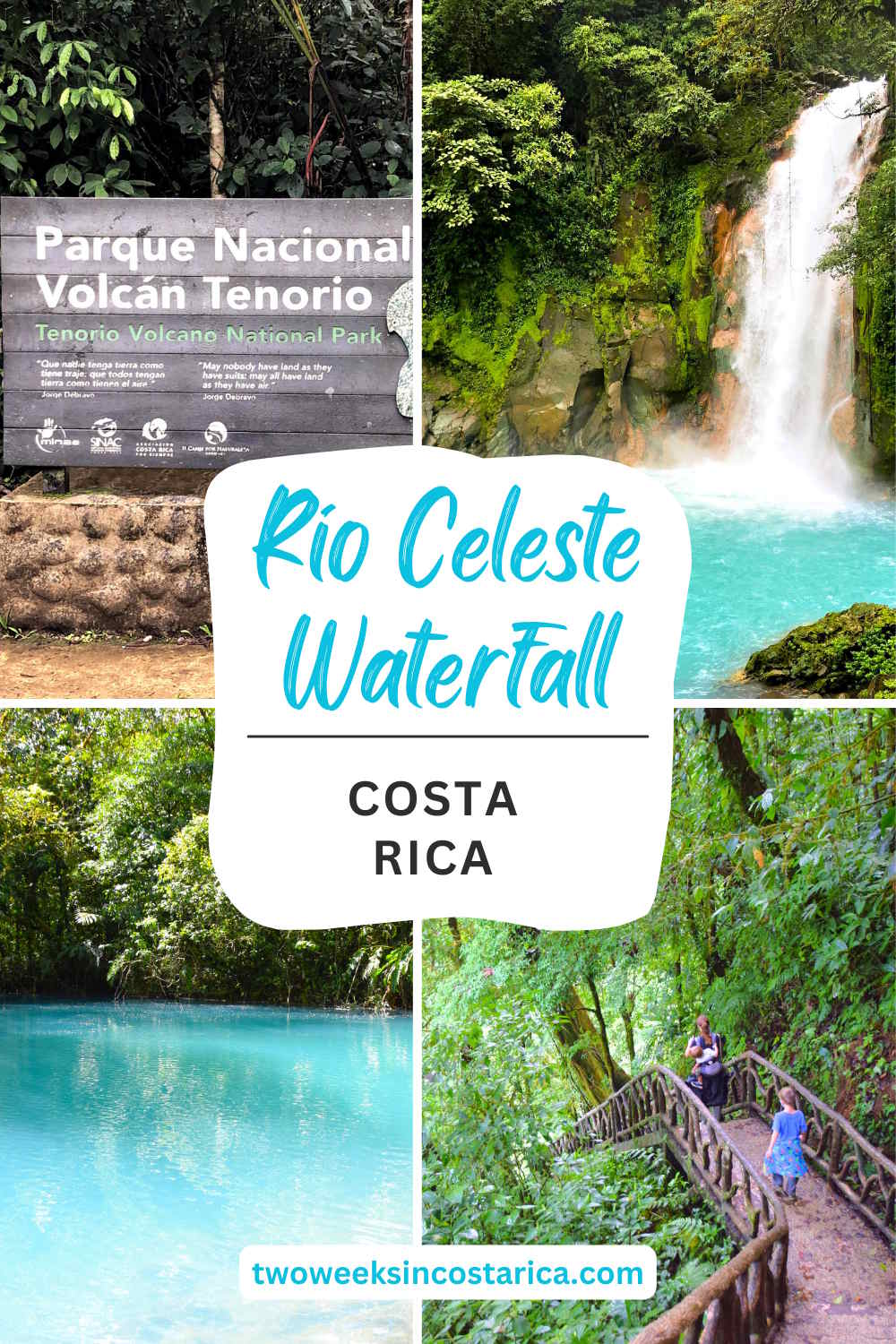
Have a question about visiting the Rio Celeste Waterfall? Ask us below.
Looking for more information to plan your trip to Costa Rica? Check out these posts:
Renting a Car in Costa Rica: Clearing Up the Confusion – A rental car is good to have for exploring the Rio Celeste area since it’s more spread out. Read our tips on what to look out for renting a car in Costa Rica.
Best Things to Do in Bijagua: The small town of Bijagua is the perfect jumping off point for visiting the Rio Celeste Waterfall, plus it has other fun activities like uncrowded hanging bridges, frog tours, and sloth tours. Or view all the tours we recommend in one place on our Bijagua Tours page.
Blue Falls of Costa Rica: This set of twin waterfalls near Bajos del Toro has a similar blue color to the Rio Celeste without the crowds.
Things to Do in Costa Rica: Our Things to Do articles cover 150+ activity options for everything from the best national parks to hot springs.


